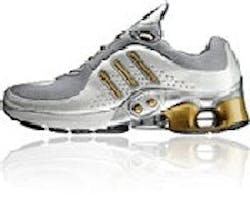Smart shoe uses sensor and magnet to level cushioning
|
A |
fter three years of highly confidential in-house development, adidas has unveiled "1", an advanced shoe that provides intelligent cushioning by automatically and continuously adjusting itself using a sensor and a magnet. The shoe understands whether the cushioning level is too soft or too firm via a small computer and adapts with a motor-driven cable system to provide the correct cushioning throughout the run.
Adidas says it has created the world's first "smart shoe" by mating it with a computer chip that adapts its cushioning level to a runner's size and stride. Developed at its U.S. headquarters in Portland, Ore., the microprocessor is located in the arch of the shoe, and drives a tiny screw and cable system that adjusts the heel cushion depending on the signals sent back by an electric sensor coupled to a magnet. It is powered by a battery that conserves power by adjusting the shoe while it is in the air during a runner's stride, avoiding resistance from the ground."This product will change the entire sporting goods industry," said Erich Stamminger, Executive Board Member responsible for Global Marketing and North America. "This is the product that illustrates to us that 'Impossible is Nothing'."
The entire assembly weighs no more than 40 grams -- just 10% of the 400-gram total weight of the shoe, keeping it light enough for distance runners. An exclusive distribution of shoes is now available in select retailers and adidas Sport Performance stores and retail for about $300.


